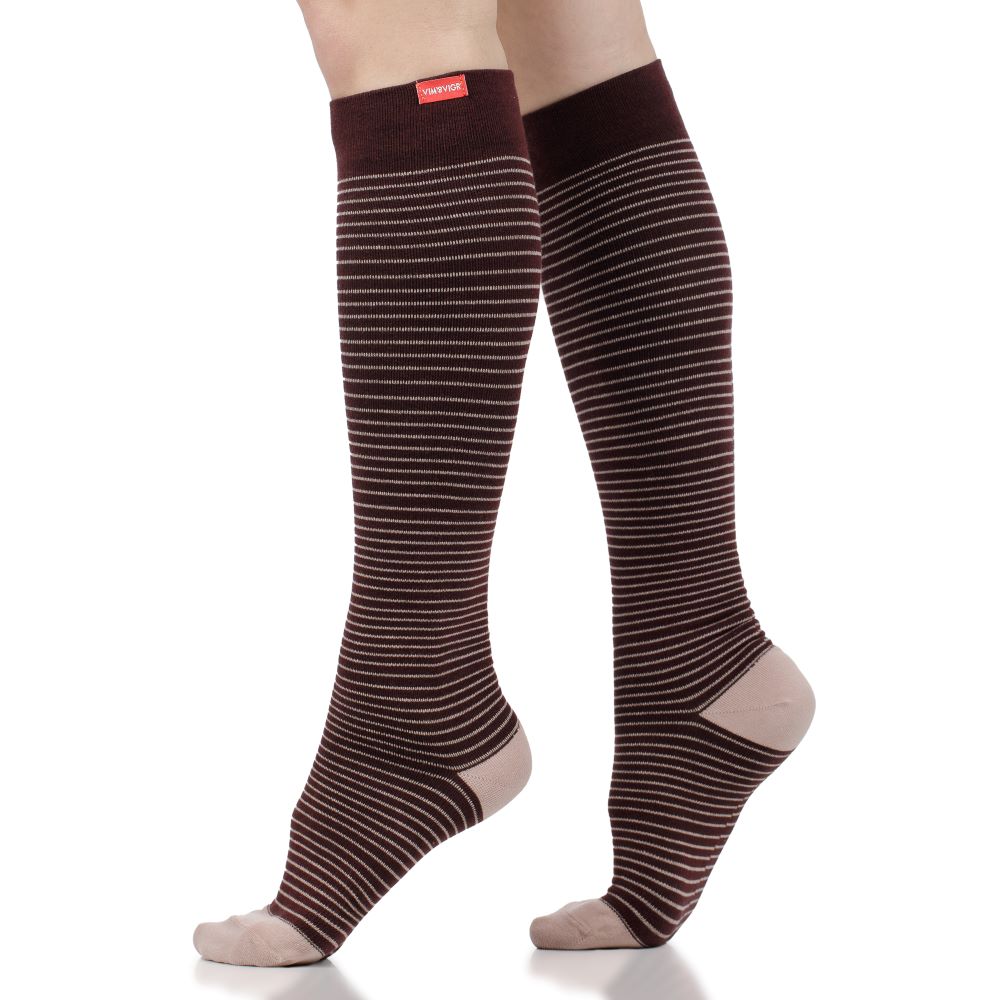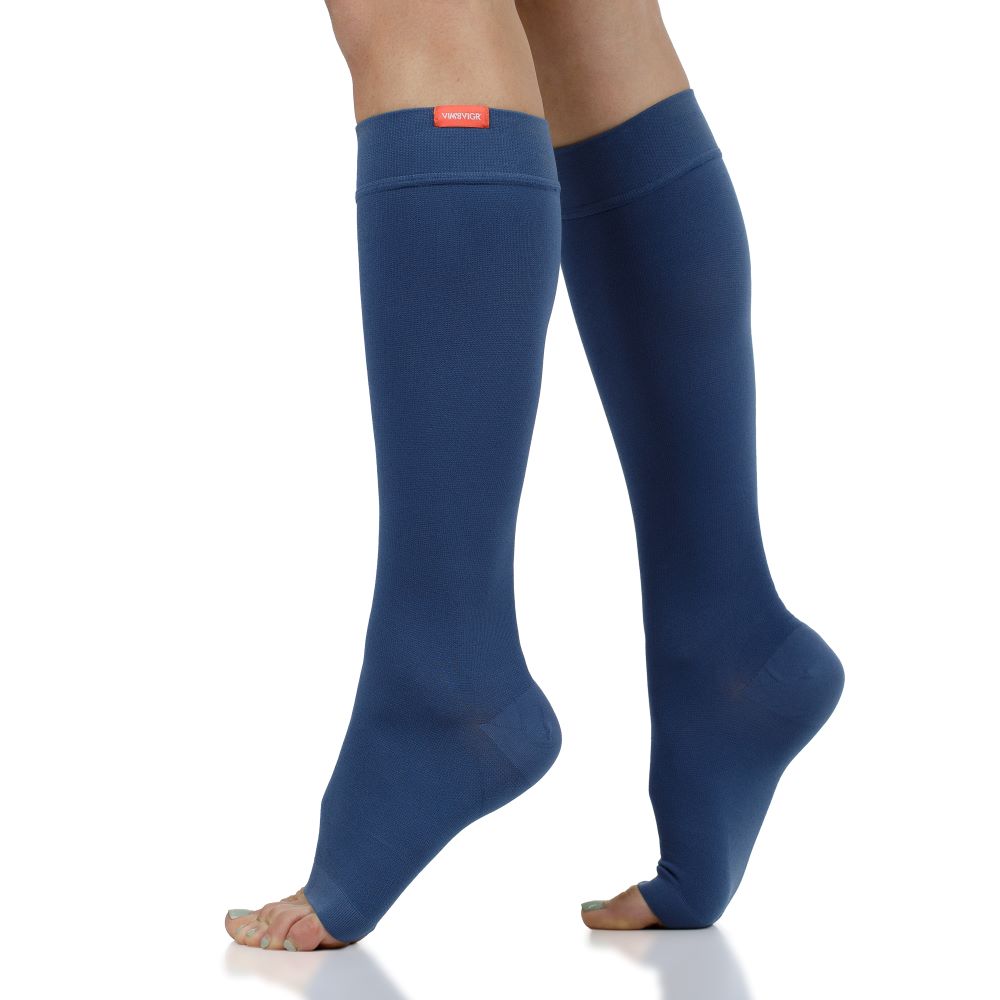Is Merino Wool Itchy?
We’ve covered the benefits of Merino wool for your compression socks, from keeping your feet dry in all types of weather to being antibacterial and odor free. However, Merino wool is still wool, so you’ll be wondering if it’s as itchy as you would expect from the material.
Merino wool is not as itchy (or even, at all!) as you would expect. The fibers that make up Merino wool are thinner than those in regular wool, which makes them more flexible. That’s what avoids your garments becoming itchy - no resistance as they press against your skin.
So, let’s talk about why Merino wool doesn’t itch and how you can choose compression socks or any other garments in this material for your needs. However, we do acknowledge some people might find Merino itchy - so we’ll tell you what causes that, too.

Does Merino Wool Itch?
The short answer is: no, Merino wool shouldn’t be itchy. That’s because of the fibers in Merino wool, which are different from those found in regular wool.
Wool is made of fibers that can feel rough against the skin. When these are shorter, as well, they can fray more easily, also causing itchiness. However, Merino fibers are thinner, causing them to be more flexible and less coarse against the skin. They also don’t fray as much (thanks to their flexibility).
Why Is Regular Wool Itchy?
You’ll be wondering why one type of wool is itchy while another isn’t. After all, it’s all the same basic material. The answer is two-fold: the make-up of wool and the reasons we itch.
Firstly, the fibers that go into regular wool are thicker than the ones produced by Merino sheep. We measure the fine-ness of fabric in microns: regular wool fibers depend on the breed of the sheep, but are usually more than 25 microns thick. The older the sheep, the coarser the wool is, too. This is why lamb’s wool is thinner and finer.
Merino sheep’s wool fibers’ diameter is 15-25 microns, or even finer still. To give you an idea of what that means, most human hair is 60-120 microns in diameter.
This makes it lightweight, soft, flexible and non-itchy. When the fabric rubs against your skin, it will not only not fray as easily as regular wool, but it will also bend and adjust to the body’s movements to keep you comfortable.
Secondly, we need to talk about why we itch. The skin is our first line of defense against any external invasion, from critters to scrapes and scratches caused by different obstacles. This is why, as soon as there is an irritant in its vicinity, it will become itchy to alert us. Itchiness is therefore caused by things we are allergic to, by bugs, or by certain clothing fibers. So, if you wear soft, malleable clothing made of high-quality fabrics that don’t irritate your skin, you shouldn’t get itchy… unless you have an allergy, of course.
Characteristics of Merino Wool That Make it Non-Itchy
Thanks to its make-up, Merino wool is one of the most comfortable fabrics for clothing. Its fine fibers, sometimes even under 17.5 microns in diameter (in the case of ultrafine Merino) allow it to be used in very lightweight, flexible, and comfortable items such as compression socks, base layers, and thermal underwear.
Another added benefit of wearing Merino garments if you have sensitive skin, especially compared to traditional wool clothing, is that they are hypoallergenic. Merino wool is composed of keratin, the same protein we have in our hair and skin. The similarity to our own skin make-up should make it very unlikely that you would develop an allergic reaction to it, which would start with itching.
Finally, one characteristic of Merino wool is that it dries quickly and allows air to travel between the exterior and your skin. Merino fibers can absorb up to 30% of their weight in moisture, but still feel dry to the touch, keeping you comfortable even when you sweat. Then, the moisture is released into the air, which keeps your garments lightweight (compared to regular wool which becomes heavy when wet). All this means that you have less of a chance for bacteria to form in between your clothes and your skin (as they thrive in humid conditions) and that you’re therefore less likely to feel itchy and uncomfortable because of sweat. This is why runners and hikers enjoy wearing Merino socks and base layers so much, even over several days.

Is Merino Wool Less Itchy than Cashmere?
Merino wool is soft and comfortable, just like cashmere. However, it is a type of wool, which means it contains lanolin. This waxy substance produced naturally by sheep has similar properties to our own sebum production by the skin and is meant to protect the wool. It is moisturizing, but it can cause some adverse reactions. Among them, of course, is itchiness.
Cashmere, on the other hand, is sourced from the cashmere goat. Just like alpaca or Merino wool, cashmere is also considered wool, but it has slightly different properties. Cashmere is soft and malleable and doesn’t contain lanolin, reducing the chances of feeling itchy as a result of lanolin allergy.
The main drawback of cashmere is its scarcity, which leads to it being very pricey. While sheep can provide over a kilo of wool per year, cashmere goats make about 100 grams of yarn per season. This is why cashmere is seen as much more of a luxury product.
Is Merino Wool Soft?
Yes, thanks to the thin, flexible fibers that make up Merino wool, this fabric is known for its softness. Merino wool is ideal for wearing against the skin, so it is popular for base layers, underwear and socks that need to be dry and moisture wicking (such as for hiking and walking).
Why Merino Wool Might Be Itchy for Some People
As we’ve mentioned, there are people who may find Merino wool itchy, despite the fact that it shouldn’t be so, on paper. Most of the time, this is because of the quality of the clothing. Sometimes, it can be a personal allergic reaction to either the lanolin or wool fibers in general.
The Merino Wool is Low Quality
To avoid discomfort or itchiness, you need to ensure that the Merino wool clothing you wear is high quality. We’re not the first to tout the benefits of Merino - many brands are trying to sell their products which include a Merino mix or lower-quality wool. This is not to say that those items are not good-quality. But, if your compression socks or wool shirts are made from a blend, there are other types of fiber in there that can cause an itch.
Similarly, if the fabric is low-quality or has been treated with chemicals in the process of making the clothing, this can make it itchy. The best way to avoid this is to consult other consumers’ reviews before buying from any store that you have doubts about.
Finally, it’s important to check how your clothing is made overall. Exposed, rough seams can cause you to get itchy or irritated even if you are wearing Merino wool. The best clothing for running, for example, features flat seams and is specifically designed to prevent chafing. These are the sort of things you can also check before buying a garment.
Individual Sensitivity or Allergy to Wool Fibers
Either the lanolin present in all wool fibers or other elements of the fabric could cause you to have an allergic reaction. This makes you itchy - so check with your doctor if this happens with more than one item of Merino wool clothing.
Moreover, if you suffer from other skin issues like eczema, there may be a personal sensitivity to more than one type of fabric that’s making your skin itch. While Merino wool is great against sensitive skin, it cannot cure medical conditions. So, check with your doctor if you have any doubts around this.
Tips for Choosing Quality Merino Wool Garments
To make the most of your Merino wool clothing and avoid getting that itch, here’s how to go about choosing your items:
- Make sure the fabric is high-quality and - as much as possible - not a blend with other materials that you could be allergic to. To do this, check reviews online and research the make-up of clothing before you order;
- Check the seams. You need flatlock seams to ensure no rubbing against the skin. “Anti-chafing” is also a good keyword;
- Double check that you don’t have a wool allergy or a skin condition that would cause you to be uncomfortable wearing Merino wool;
- Get the right size. Yes, this sounds obvious, but when you’re hiking in a top that’s too loose, you may end up getting chafed or itchy simply because of how much the extra fabric moves around, trapping sweat or outside humidity against your skin or rubbing against other clothes.
Why Merino Wool is an Ideal Material for Compression Socks
If you’re looking for a material that can keep your feet dry in all temperatures, fight odor and bacteria, and feel comfortable for the long haul, Merino wool ticks all the boxes. Because of its highly breathable make-up, Merino is great to wear for keeping warm in winter, but also cool in summer (with the added bonus of drying quickly, even if you step in a puddle!).
All this means that Merino wool compression socks can be a great match for almost any activity and situation. High-quality compression socks apply gentle pressure onto your lower limbs, supporting your blood circulation, while also keeping you comfortable and pain-free. Couple that with moisture-wicking softness and great thermoregulation from the Merino wool fibers and you have a perfect item for hiking, running, relaxing by the fire, or skiing.
Have a look at our Merino wool collection to get some outfit inspiration.



















Leave a comment